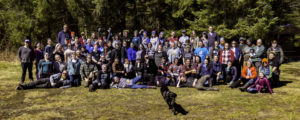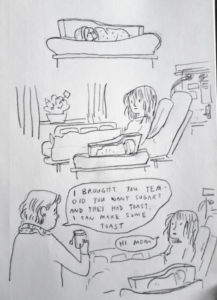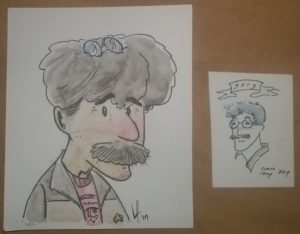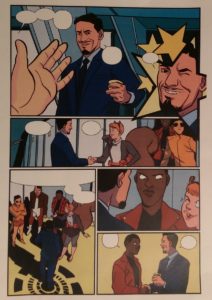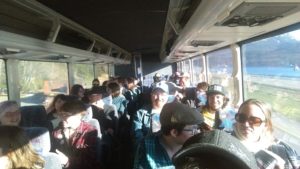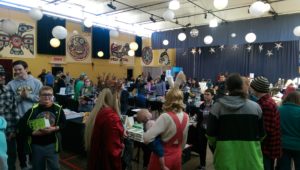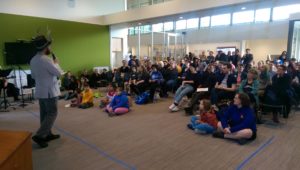Thanks, I Needed That
Hey, thanks for that time off. As readers of this page probably know, I traditionally spend the end of April at Alaska Robotics Comics Camp, which means I’m largely off the grid for a week or so. And as anybody probably knew, the entire world is full of canceled or postponed events, and Camp was one of them. Big sads all around.
But Pat Race and Aaron Suring, the stellar fellows behind AK Robotics, Camp, and numerous other projects, got a brainstorm that at least some part of the Camp experience could be improvised online. It was a last-minute thing because of other stuff they had front-burnered, but it came together. Over the space of five days nearly three dozen sessions occurred, mostly on Zoom, with Camp alumni and would-have-been first-timers coming together to form the intentional and intensely weird community that coalesces around Camp each year.
I already had vacation time blocked out for Camp that left me with no work obligations, so I decided to replicate the Camp experience as much as possible — between the round trip to Alaska and the fact that there’s no internet at Camp itself, I opted to step back from social media and the news¹ for the same period of time that I would have been gone anyway. The only question is if it would succeed the way that people really needed it to.
Yes, Zoom sucks² and we’ve all got Zoom fatigue, but it worked; it worked to the degree that during the opening session, which was mostly just people introducing themselves, saw attendance go up during the nearly 90 minutes it took for everybody to say hi. It worked to the degree that people who were supposed to attend Camp for the first time raved about the virtual experience and have had to recalibrate their expectations for the real thing being even better. There may not have been campfires, drizzle, ravens, and s’mores, but it worked.
There were skills demos, hangout time, socially distant boardgames, and one memorable presentation on the evolution of orcs in fiction, games, and fanart (from the original evil and pretty racist sword-fodder to he big to the modern pinnacle of he big and horny³). There are plans for a zine of favorite recipes (a quaran-zine full of cui-zine, if you will). People that might not have been able to make it regardless of pandemic got to attend. Relationships were established and re-established. Cats and dogs showed up on camera. By my estimation, at least a half-dozen people were logged in every hour the Camp events were running.
I’m not sure there’s a lesson here other than one that we all already know — human connection is important — but it’s worth reiterating. Every year at Camp I give a variation of Lesson One that we teach to Lil’ Baby EMTs — You are the most important person in the world, your safety and well-being are paramount, you cannot help anybody unless you first take care of yourself — and I’ll admit that this year I was saying it as much for myself as for anybody else that needed to hear it. The theme kept coming up, at discussions of [waves hand] all of this, of economic realities, of cooking, pretty much nonstop: I don’t want to ask for help. Other people have it worse. I’m doing okay.
Everybody that said it was sincere, and everybody that heard it was also sincere in stomping on that shit and saying Stop. It’s okay to ask for help. Any kind of help. And the thing is, I’m pretty sure that everybody was, at some point or another, on either side of that exchange. There’s a lot of self-denial going around, mixed with a lot of (in many cases, frustrated) desire to help others.
There’s room for a lot of intentional and intensely weird communities out there, and I encourage you to find and/or found them as you need to. For some of you that will mean applying to #ComicsCamp next time it comes around. For others, it will be grabbing friends and friends-of-friends and getting online and just hanging out being awesome/stupid together. For all of us, it will be a step towards a better frame of mind while we’re still taking rainchecks on the in-person connections we’re all so desperately craving.
Oh, and if you did want to take a whack at forming your own community — online for now, maybe IRL later — Pat and Aaron are full of excellent ideas and have worked out a lot of wrinkles. Maybe they could add a We advise you on community building and support tier to the Alaska Robotics Patreon4? Regardless — take a deep breath, make some contacts, and go lift each other up. The world and all of its bullshit will still be here when you get back, but the burden will be a little bit lighter.
Spam of the day:
I was going to include the email I got offering me quick turnaround on mortuary body racks, but that one got me so mad that I called the company to yell at them for spamming something so inappropriate, and it turned out that one of the other Garies Tyrrell (who thinks my email is his email) was supposed to be the recipient. So not evil spam after all!
_______________
¹ As much as I’ve written here in years past that Camp is a place that gets my head on straight, I have to acknowledge the act of stepping away from the shouty echo chamber is a big contributor to that rejuvenation.
² It’s also a tool I’ve used all day, nearly every day, for more than two years at the day job. I like to think that my Zoom wrangling skills helped make it suck a little less for the virtual Campers.
³ It was the mostly hilariously WHAT-filled ten minutes of the past decade.
4 Which could use your support, or maybe take a look at the prints, shirts, comics, calendars, postcards, and other stuff at their shop, which they won’t be able to take to/sell at conventions, or out of their store in Juneau, which is likely seeing its entire tourist season drop to zero.

